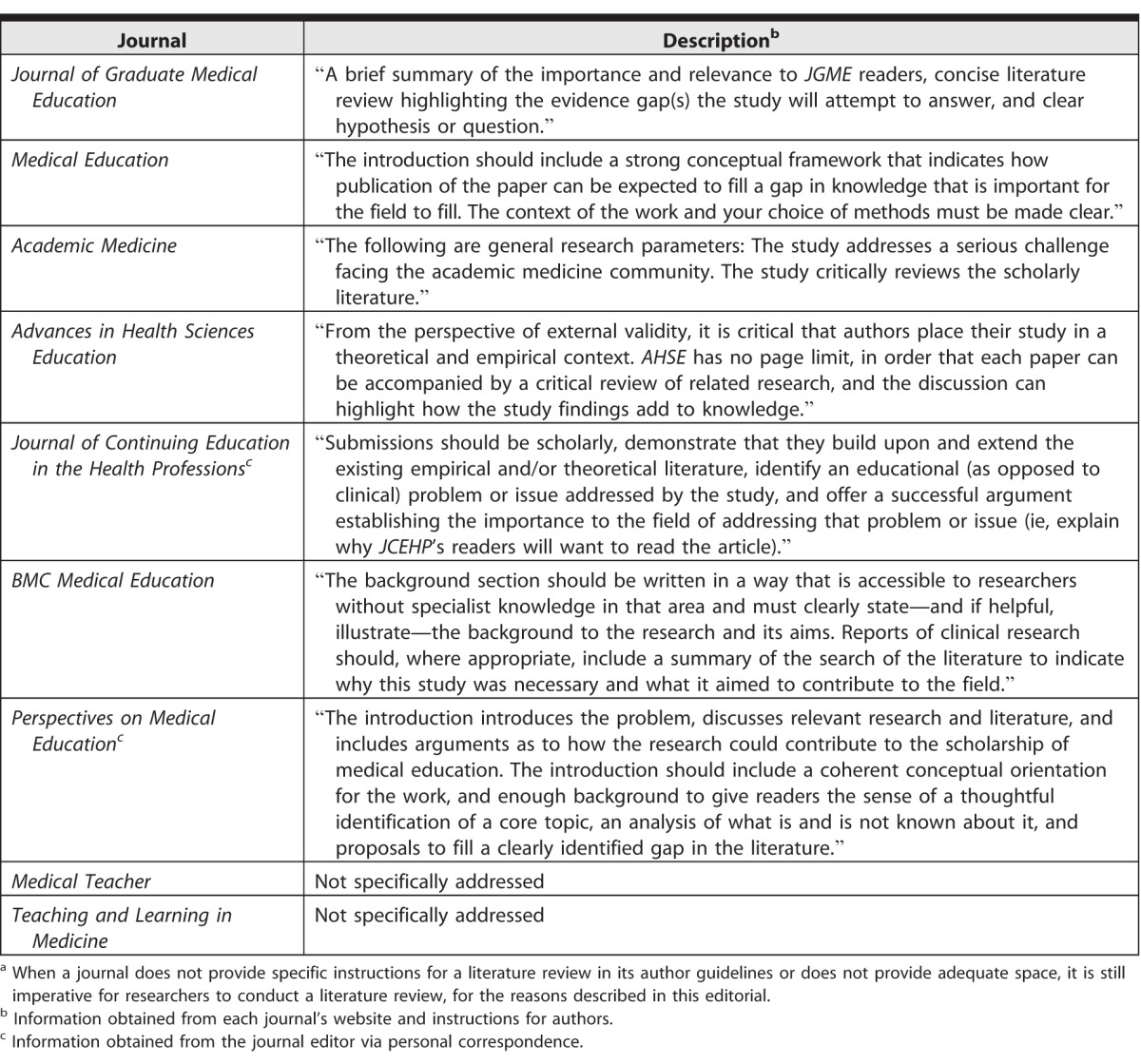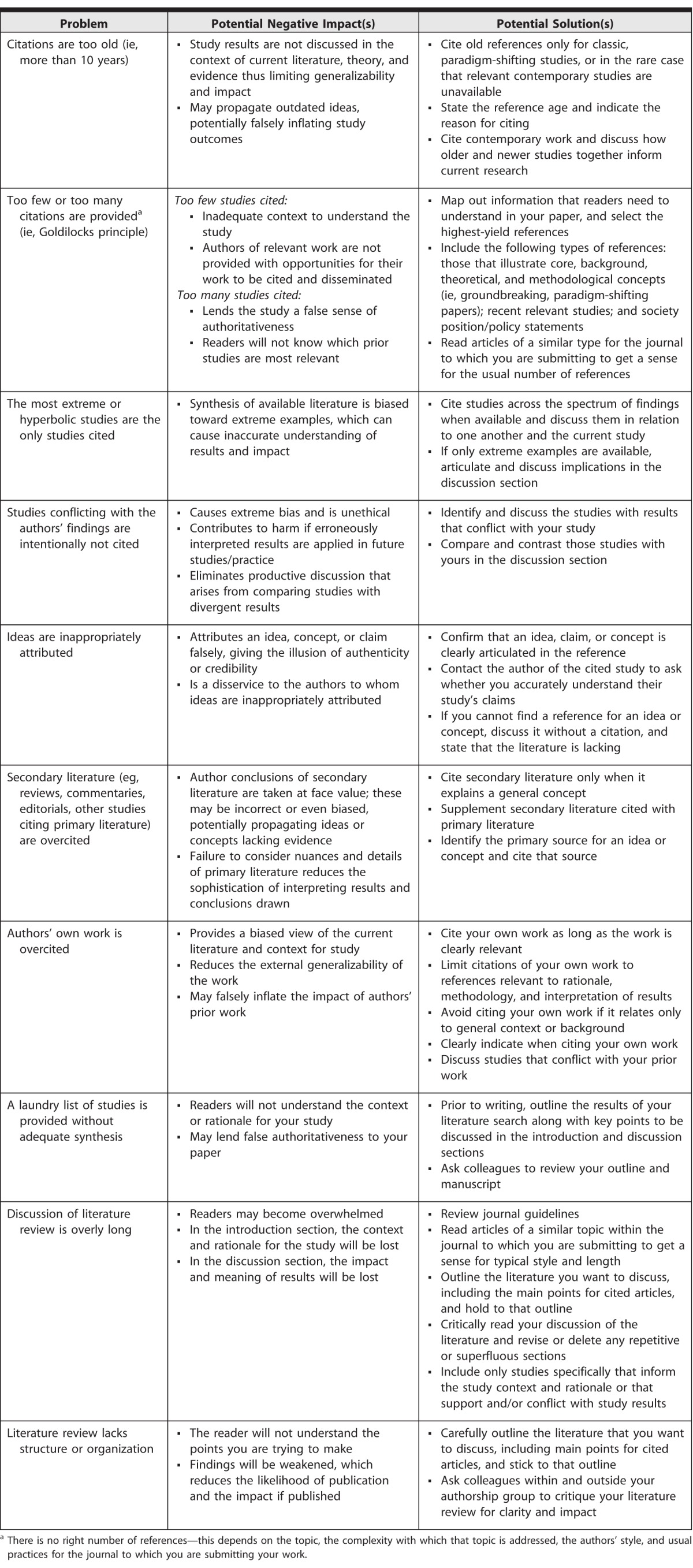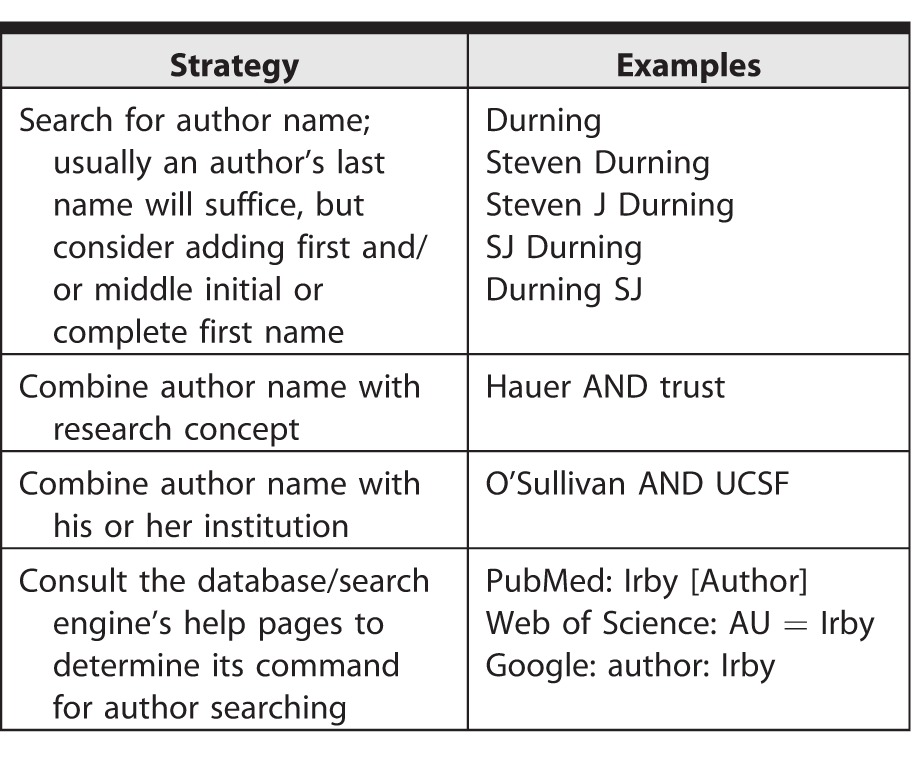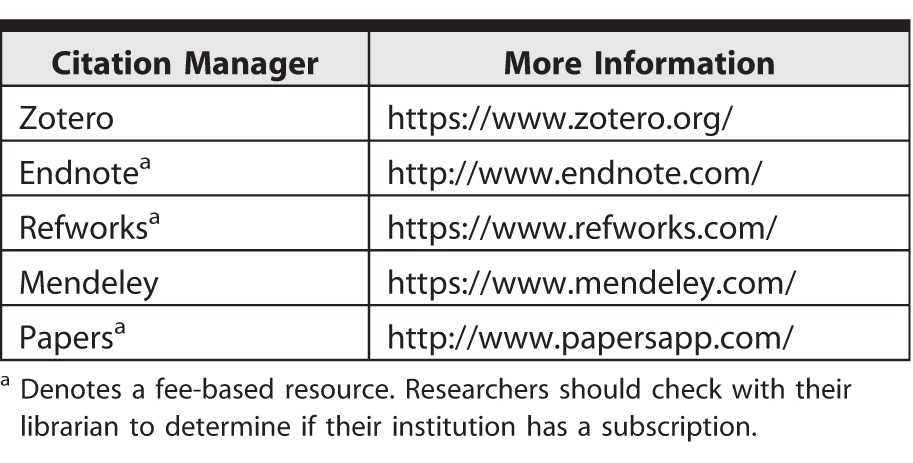a These are subscription resources. Researchers should check with their librarian to determine their access rights.
Despite a surge in published scholarship in medical education1 and rapid growth in journals that publish educational research, manuscript acceptance rates continue to fall.2 Failure to conduct a thorough, accurate, and up-to-date literature review identifying an important problem and placing the study in context is consistently identified as one of the top reasons for rejection.3,4 The purpose of this editorial is to provide a road map and practical recommendations for planning a literature review. By understanding the goals of a literature review and following a few basic processes, authors can enhance both the quality of their educational research and the likelihood of publication in the Journal of Graduate Medical Education (JGME) and in other journals.
The Literature Review Defined
In medical education, no organization has articulated a formal definition of a literature review for a research paper; thus, a literature review can take a number of forms. Depending on the type of article, target journal, and specific topic, these forms will vary in methodology, rigor, and depth. Several organizations have published guidelines for conducting an intensive literature search intended for formal systematic reviews, both broadly (eg, PRISMA)5 and within medical education,6 and there are excellent commentaries to guide authors of systematic reviews.7,8
Key Points
A literature review forms the basis for high-quality medical education research and helps maximize relevance, originality, generalizability, and impact.
A literature review provides context, informs methodology, maximizes innovation, avoids duplicative research, and ensures that professional standards are met.
Literature reviews take time, are iterative, and should continue throughout the research process.
Researchers should maximize the use of human resources (librarians, colleagues), search tools (databases/search engines), and existing literature (related articles).
Keeping organized is critical.
Such work is outside the scope of this article, which focuses on literature reviews to inform reports of original medical education research. We define such a literature review as a synthetic review and summary of what is known and unknown regarding the topic of a scholarly body of work, including the current work's place within the existing knowledge. While this type of literature review may not require the intensive search processes mandated by systematic reviews, it merits a thoughtful and rigorous approach.
Purpose and Importance of the Literature Review
An understanding of the current literature is critical for all phases of a research study. Lingard9 recently invoked the “journal-as-conversation” metaphor as a way of understanding how one's research fits into the larger medical education conversation. As she described it: “Imagine yourself joining a conversation at a social event. After you hang about eavesdropping to get the drift of what's being said (the conversational equivalent of the literature review), you join the conversation with a contribution that signals your shared interest in the topic, your knowledge of what's already been said, and your intention.”9
The literature review helps any researcher “join the conversation” by providing context, informing methodology, identifying innovation, minimizing duplicative research, and ensuring that professional standards are met. Understanding the current literature also promotes scholarship, as proposed by Boyer,10 by contributing to 5 of the 6 standards by which scholarly work should be evaluated.11 Specifically, the review helps the researcher (1) articulate clear goals, (2) show evidence of adequate preparation, (3) select appropriate methods, (4) communicate relevant results, and (5) engage in reflective critique.
Failure to conduct a high-quality literature review is associated with several problems identified in the medical education literature, including studies that are repetitive, not grounded in theory, methodologically weak, and fail to expand knowledge beyond a single setting.12 Indeed, medical education scholars complain that many studies repeat work already published and contribute little new knowledge—a likely cause of which is failure to conduct a proper literature review.3,4
Likewise, studies that lack theoretical grounding or a conceptual framework make study design and interpretation difficult.13 When theory is used in medical education studies, it is often invoked at a superficial level. As Norman14 noted, when theory is used appropriately, it helps articulate variables that might be linked together and why, and it allows the researcher to make hypotheses and define a study's context and scope. Ultimately, a proper literature review is a first critical step toward identifying relevant conceptual frameworks.
Another problem is that many medical education studies are methodologically weak.12 Good research requires trained investigators who can articulate relevant research questions, operationally define variables of interest, and choose the best method for specific research questions. Conducting a proper literature review helps both novice and experienced researchers select rigorous research methodologies.
Finally, many studies in medical education are “one-offs,” that is, single studies undertaken because the opportunity presented itself locally. Such studies frequently are not oriented toward progressive knowledge building and generalization to other settings. A firm grasp of the literature can encourage a programmatic approach to research.
Approaching the Literature Review
Considering these issues, journals have a responsibility to demand from authors a thoughtful synthesis of their study's position within the field, and it is the authors' responsibility to provide such a synthesis, based on a literature review. The aforementioned purposes of the literature review mandate that the review occurs throughout all phases of a study, from conception and design, to implementation and analysis, to manuscript preparation and submission.
Planning the literature review requires understanding of journal requirements, which vary greatly by journal (table 1). Authors are advised to take note of common problems with reporting results of the literature review. Table 2 lists the most common problems that we have encountered as authors, reviewers, and editors.
Table 1.
Sample of Journals' Author Instructions for Literature Reviews Conducted as Part of Original Research Articlea

Table 2.
Common Problem Areas for Reporting Literature Reviews in the Context of Scholarly Articles

Locating and Organizing the Literature
Three resources may facilitate identifying relevant literature: human resources, search tools, and related literature. As the process requires time, it is important to begin searching for literature early in the process (ie, the study design phase). Identifying and understanding relevant studies will increase the likelihood of designing a relevant, adaptable, generalizable, and novel study that is based on educational or learning theory and can maximize impact.
Human Resources
A medical librarian can help translate research interests into an effective search strategy, familiarize researchers with available information resources, provide information on organizing information, and introduce strategies for keeping current with emerging research. Often, librarians are also aware of research across their institutions and may be able to connect researchers with similar interests. Reaching out to colleagues for suggestions may help researchers quickly locate resources that would not otherwise be on their radar.
During this process, researchers will likely identify other researchers writing on aspects of their topic. Researchers should consider searching for the publications of these relevant researchers (see table 3 for search strategies). Additionally, institutional websites may include curriculum vitae of such relevant faculty with access to their entire publication record, including difficult to locate publications, such as book chapters, dissertations, and technical reports.
Table 3.
Strategies for Finding Related Researcher Publications in Databases and Search Engines

Search Tools and Related Literature
Researchers will locate the majority of needed information using databases and search engines. Excellent resources are available to guide researchers in the mechanics of literature searches.15,16
Because medical education research draws on a variety of disciplines, researchers should include search tools with coverage beyond medicine (eg, psychology, nursing, education, and anthropology) and that cover several publication types, such as reports, standards, conference abstracts, and book chapters (see the box for several information resources). Many search tools include options for viewing citations of selected articles. Examining cited references provides additional articles for review and a sense of the influence of the selected article on its field.
Box Information Resources
PubMed
Web of Sciencea
Education Resource Information Center (ERIC)
Cumulative Index of Nursing & Allied Health (CINAHL)a
Scopusa
PsycINFOa
Google Scholar
Once relevant articles are located, it is useful to mine those articles for additional citations. One strategy is to examine references of key articles, especially review articles, for relevant citations.
Getting Organized
As the aforementioned resources will likely provide a tremendous amount of information, organization is crucial. Researchers should determine which details are most important to their study (eg, participants, setting, methods, and outcomes) and generate a strategy for keeping those details organized and accessible. Increasingly, researchers utilize digital tools, such as Evernote, to capture such information, which enables accessibility across digital workspaces and search capabilities. Use of citation managers can also be helpful as they store citations and, in some cases, can generate bibliographies (table 4).
Table 4.
Citation Managers

Knowing When to Say When
Researchers often ask how to know when they have located enough citations. Unfortunately, there is no magic or ideal number of citations to collect. One strategy for checking coverage of the literature is to inspect references of relevant articles. As researchers review references they will start noticing a repetition of the same articles with few new articles appearing. This can indicate that the researcher has covered the literature base on a particular topic.
Putting It All Together
In preparing to write a research paper, it is important to consider which citations to include and how they will inform the introduction and discussion sections. The “Instructions to Authors” for the targeted journal will often provide guidance on structuring the literature review (or introduction) and the number of total citations permitted for each article category. Reviewing articles of similar type published in the targeted journal can also provide guidance regarding structure and average lengths of the introduction and discussion sections.
When selecting references for the introduction consider those that illustrate core background theoretical and methodological concepts, as well as recent relevant studies. The introduction should be brief and present references not as a laundry list or narrative of available literature, but rather as a synthesized summary to provide context for the current study and to identify the gap in the literature that the study intends to fill. For the discussion, citations should be thoughtfully selected to compare and contrast the present study's findings with the current literature and to indicate how the present study moves the field forward.
To facilitate writing a literature review, journals are increasingly providing helpful features to guide authors. For example, the resources available through JGME include several articles on writing.17 The journal Perspectives on Medical Education recently launched “The Writer's Craft,” which is intended to help medical educators improve their writing. Additionally, many institutions have writing centers that provide web-based materials on writing a literature review, and some even have writing coaches.
Conclusion
The literature review is a vital part of medical education research and should occur throughout the research process to help researchers design a strong study and effectively communicate study results and importance. To achieve these goals, researchers are advised to plan and execute the literature review carefully. The guidance in this editorial provides considerations and recommendations that may improve the quality of literature reviews.
References
- 1. Lee K, Whelan JS, Tannery NH, Kanter SL, Peters AS. 50 years of publication in the field of medical education. Med Teach. 2013; 35 7: 591– 598. [DOI] [PubMed] [Google Scholar]
- 2. Norman G. Taking stock. Adv Health Sci Educ Theory Pract. 2014; 19 4: 465– 467. [DOI] [PubMed] [Google Scholar]
- 3. Artino AR, Jr, West DC, Gusic ME. Foreword: the more things change, the more they stay the same. Acad Med. 2015; 90 suppl 11: Si– Siii. [DOI] [PubMed] [Google Scholar]
- 4. Bordage G. Reasons reviewers reject and accept manuscripts: the strengths and weaknesses in medical education reports. Acad Med. 2001; 76 9: 889– 896. [DOI] [PubMed] [Google Scholar]
- 5. Moher D, Liberati A, Tetzlaff J, Altman DG. PRISMA Group. Preferred reporting items for systematic reviews and meta-analyses: the PRISMA statement. PLoS Med. 2009; 6 7: e1000097. [DOI] [PMC free article] [PubMed] [Google Scholar]
- 6. Harden R, Grant J, Buckley G, Hart I. BEME. Guide No. 1: best evidence medical education. Med Teach. 1999; 21 6: 553– 562. [DOI] [PubMed] [Google Scholar]
- 7. Cook DA, West CP. Conducting systematic reviews in medical education: a stepwise approach. Med Educ. 2012; 46 10: 943– 952. [DOI] [PubMed] [Google Scholar]
- 8. Hammick M, Dornan T, Steinert Y. Conducting a best evidence systematic review. Part 1: from idea to data coding. BEME Guide No. 13. Med Teach. 2010; 32 1: 3– 15. [DOI] [PubMed] [Google Scholar]
- 9. Lingard L. Joining a conversation: the problem/gap/hook heuristic. Perspect Med Educ. 2015; 4 5: 252– 253. [DOI] [PMC free article] [PubMed] [Google Scholar]
- 10. Boyer EL. Scholarship Reconsidered: Priorities of the Professoriate. San Fransisco, CA: Jossey-Bass; 2016. [Google Scholar]
- 11. Hofmeyer A, Newton M, Scott C. Valuing the scholarship of integration and the scholarship of application in the academy for health sciences scholars: recommended methods. Health Res Policy Syst. 2007; 5: 5. [DOI] [PMC free article] [PubMed] [Google Scholar]
- 12. Albert M, Hodges B, Regehr G. Research in medical education: balancing service and science. Adv Health Sci Educ Theory Pract. 2007; 12 1: 103– 115. [DOI] [PMC free article] [PubMed] [Google Scholar]
- 13. Bordage G. Conceptual frameworks to illuminate and magnify. Med Educ. 2009; 43 4: 312– 319. [DOI] [PubMed] [Google Scholar]
- 14. Norman G. Editorial—how bad is medical education research anyway? Adv Health Sci Educ Theory Pract. 2007; 12 1: 1– 5. [DOI] [PubMed] [Google Scholar]
- 15. Haig A, Dozier M. BEME. Guide No. 3: systematic searching for evidence in medical education—part 2: constructing searches. Med Teach. 2003; 25 5: 463– 484. [DOI] [PubMed] [Google Scholar]
- 16. Maggio LA, Tannery NH, Kanter SL. AM last page: how to perform an effective database search. Acad Med. 2011; 86 8: 1057. [DOI] [PubMed] [Google Scholar]
- 17. Journal of Graduate Medical Education. Resources for authors. 2015. http://www.jgme.org/page/resources_for_authors. Accessed February 2, 2016. [Google Scholar]


